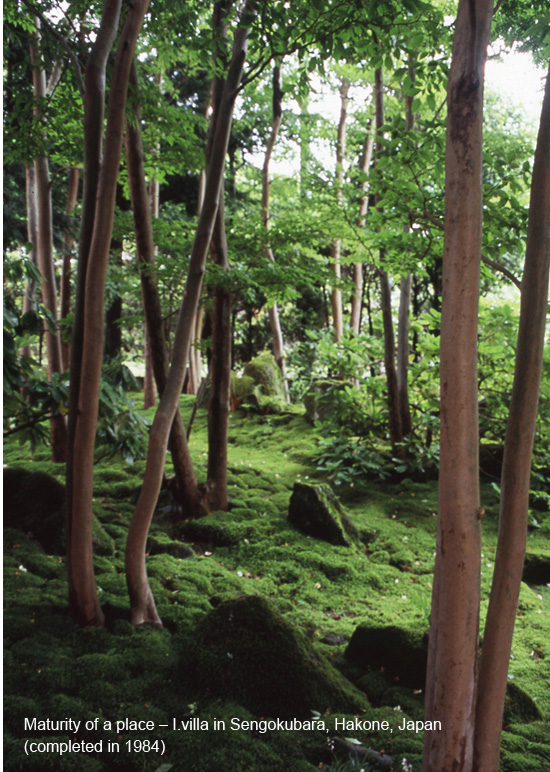

The interaction between tradition and creation is not a mere style or figure.
It is not until tradition is negatively perceived in the process of creation that it is developmentally inherited;
it is inherited in a conservative, eclectic and confrontational manner.
We will continue studying the way to amplify space design in regional landscapes and climates
whether at the scale of a garden, a city, or a country.


When traveling and gazing out of a train window without being bored, we notice that
the first sight of a foreign country gradually fills the spaces of our fragmented knowledge
of the country; the wide expanse of landscape stretching to the horizon, the rich pattern
of fields and countryside, the lakes and forests, and historic streetscapes – these actual
experiences construct a much more comprehensive understanding of the landscape
and climate.
Yet a landscape we know through photographs and movies is not directly associated
with the living system. It is nothing more than a fake piece of landscape and nature.
A real landscape, and especially a kind of landscape with which we are familiar from
an early age, is something taken deeply into our heart through our experiences with
all of our senses and our mind’s eye.

When our landscape architects design a place, we apply the key landscape, the local materials such as trees, stones and other materials associated with the region, and the local traditional technique as a symbolic representation. We believe that this clarifies the sense of place being unique, different from anywhere else.


The phenomenon of deepening one’s emotion in sympathy with the immediate environment is
called a "sentiment".
The Japanese have a culture of seasonal words,
and as such we are sympathetic to the signs of
seasonal change represented by flowers,
fragrances, birds, insects and other things
associated with each period of the year.
We also have a particular liking for a number
of sounds such as sounds of kakehi*,
a deer scarer (shishiodoshi), suikinkutsu**,
winds blowing through pines, the singing of
insects and water running along a stream.
All of these sensibilities remain alive in
Japanese people today.

**suikinkutsu: [a garden feature] a buried earthen jar that makes a sound when water drips into it.

The world of sound is an extension of the sounds that we heard in the mother’s womb.
What most vividly evoke distant memories are life experiences through the medium of sound.
Such familiar sounds are messages from nature and the landscape, and they constitute pieces of information.
Sound helps us to remember things deep down in our memories,
and tells us of invisible events occurring in the immediate environment.

A symbol is able to communicate a variety of representation
– so much more than something real – and it also has strong power to
capture the interest of people.
The strange Gothic-looking forms of the Church of Sagrada Familia,
designed by Antonio Gaudi, whose style owes much to the climate and
nature of Catalonia, provides a sense of something extraordinary to
anyone seeing it for the first time.
However, having seen it in the context of the landscape in Catalonia,
where Gaudi was brought up, the forms seem less incongruous.
It soon becomes obvious that the silhouette of the form is a representation of
the vertical natural form of the forest in the suburbs of Barcelona.
Sagrada Familia – it is probably a symbol of the God which Gaudi was trying to represent as a likeness of the forest.


When passing through a landscape, people memorize the features of the landscape through repetition and comparison of the figure and the ground.
This is the effect of actual experience.
Forms can be seen as somewhat nostalgic, or having a resemblance to something in the context of the experience of the viewer and the surrounding landscape.
Therefore, it is strange to make forms and imitations without the meaning and inevitability.


As we learn from the earth and cultivate our mind, we have gained knowledge and intelligence from nature and on-site works, and we have reflected ancient wisdom in our designs and methods of growing plants.
Therefore, we have to spend as much time and energy as possible on making preliminary studies so as to broadly assess the conditions of a site before actually beginning to develop a project. Having done that, we must also be ready to look at the core element of a scheme – not only for what it is, but also as a way of orientating it in relation to its surroundings. In some cases we need to be moderate, in keeping with the sprit of not creating without careful consideration.
In the field of Landscape Design, things not only at a visible level but also at an invisible level have sincerity, contentment and spirit which can affect people emotionally, and lead people unconsciously into a kind of comfortable paradise.
We will continue to be particular about forms in Landscape Design, and actualize them on the earth as our canvas, while also refining what we do.
Having done this, it is time to sit back and watch how a scheme matures with the passing of time.

